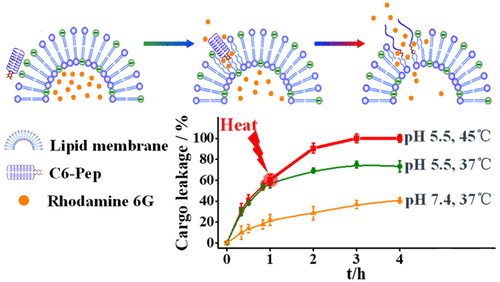Our official English website, www.x-mol.net, welcomes your
feedback! (Note: you will need to create a separate account there.)
Disruption of Tumor Cells Using a pH-Activated and Thermosensitive Antitumor Lipopeptide Containing a Leucine Zipper Structure
Langmuir ( IF 3.7 ) Pub Date : 2018-06-18 00:00:00 , DOI: 10.1021/acs.langmuir.8b00474 Sijia Wang 1 , Tong Wang 1 , Junqi Zhang 2 , Shouhong Xu 1 , Honglai Liu 1
Langmuir ( IF 3.7 ) Pub Date : 2018-06-18 00:00:00 , DOI: 10.1021/acs.langmuir.8b00474 Sijia Wang 1 , Tong Wang 1 , Junqi Zhang 2 , Shouhong Xu 1 , Honglai Liu 1
Affiliation

|
Antitumor peptides may potentially alleviate the problem of chemoresistance but do not yet target tumor cells and would be cytotoxic to normal cells. Here, we designed a pH-activated and thermosensitive lipopeptide (C6-Pep) containing a leucine zipper and an alkyl chain and assessed the ability of C6-Pep to kill cancer cells. Pep, the same sequence without the N-terminal hexanoic acid moiety, was generated as a less hydrophobic control. First, lipopeptide adsorption into lipid monolayers was studied using Langmuir–Blodgett and polarization modulation infrared reflection adsorption spectroscopy. Under weakly acid conditions, electrostatic interactions between C6-Pep and negatively charged phospholipids increased the adsorption/insertion of C6-Pep (vs Pep) into lipid monolayers. Cargo leakage from liposomes was assayed to model lipopeptide-induced lipid membrane disruption. The ability of C6-Pep to disrupt liposomes depended on the peptide molecular structure/hydrophobicity, solution pH, and temperature-induced uncoiling of the zipper structure; the greatest cargo leakage from the liposome with negative charge was observed for C6-Pep at pH 5.5 under mildly hyperthermic conditions (45 °C). In vitro, C6-Pep was significantly more cytotoxic toward HeLa cells at pH 5.5 under hyperthermic conditions than at pH 7.4 and/or 37 °C. Overall, this study demonstrates that amphipathic C6-Pep can insert into cell membranes in the low-pH tumor microenvironment, whereas the application of heat promotes the uncoiling of the zipper structure, leading to the disruption of tumor cell membranes and cell death. pH-activated and thermosensitive C6-Pep represents a promising tool to kill cancer cells via a strategy that does not invoke chemoresistance and may have low side effects.
中文翻译:

使用包含亮氨酸拉链结构的pH激活和热敏抗肿瘤脂肽破坏肿瘤细胞
抗肿瘤肽可以潜在地减轻化学抗性的问题,但尚未靶向肿瘤细胞,并且对正常细胞具有细胞毒性。在这里,我们设计了一个包含亮氨酸拉链和烷基链的pH激活的热敏脂肽(C6-Pep),并评估了C6-Pep杀死癌细胞的能力。Pep,没有N端己酸部分的相同序列,作为疏水性较弱的对照产生。首先,使用Langmuir-Blodgett和偏振调制红外反射吸收光谱法研究脂肽在脂质单分子层中的吸附。在弱酸性条件下,C6-Pep和带负电荷的磷脂之间的静电相互作用增加了C6-Pep(相对于Pep)在脂质单层中的吸附/插入。分析脂质体的货物泄漏以模拟脂肽诱导的脂质膜破坏。C6-Pep破坏脂质体的能力取决于肽的分子结构/疏水性,溶液的pH值以及温度引起的拉链结构的开卷;在温和的高温条件下(45°C),在pH值为5.5的情况下,对于C6-Pep,从带负电荷的脂质体中泄漏的货物最大。在体外,在高温条件下,pH值为5.5时,C6-Pep对HeLa细胞的细胞毒性比在pH值7.4和/或37°C时明显更大。总体而言,这项研究表明,两亲性C6-Pep可以在低pH值的肿瘤微环境中插入细胞膜,而施加热量会促进拉链结构的开卷,从而导致肿瘤细胞膜破裂和细胞死亡。
更新日期:2018-06-18
中文翻译:

使用包含亮氨酸拉链结构的pH激活和热敏抗肿瘤脂肽破坏肿瘤细胞
抗肿瘤肽可以潜在地减轻化学抗性的问题,但尚未靶向肿瘤细胞,并且对正常细胞具有细胞毒性。在这里,我们设计了一个包含亮氨酸拉链和烷基链的pH激活的热敏脂肽(C6-Pep),并评估了C6-Pep杀死癌细胞的能力。Pep,没有N端己酸部分的相同序列,作为疏水性较弱的对照产生。首先,使用Langmuir-Blodgett和偏振调制红外反射吸收光谱法研究脂肽在脂质单分子层中的吸附。在弱酸性条件下,C6-Pep和带负电荷的磷脂之间的静电相互作用增加了C6-Pep(相对于Pep)在脂质单层中的吸附/插入。分析脂质体的货物泄漏以模拟脂肽诱导的脂质膜破坏。C6-Pep破坏脂质体的能力取决于肽的分子结构/疏水性,溶液的pH值以及温度引起的拉链结构的开卷;在温和的高温条件下(45°C),在pH值为5.5的情况下,对于C6-Pep,从带负电荷的脂质体中泄漏的货物最大。在体外,在高温条件下,pH值为5.5时,C6-Pep对HeLa细胞的细胞毒性比在pH值7.4和/或37°C时明显更大。总体而言,这项研究表明,两亲性C6-Pep可以在低pH值的肿瘤微环境中插入细胞膜,而施加热量会促进拉链结构的开卷,从而导致肿瘤细胞膜破裂和细胞死亡。











































 京公网安备 11010802027423号
京公网安备 11010802027423号